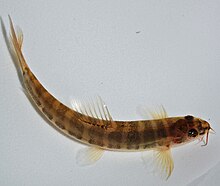| Nemacheilus | |
|---|---|
 | |
| Barred Loach (N. fasciatus) | |
| Scientific classification | |
| Domain: | Eukaryota |
| Kingdom: | Animalia |
| Phylum: | Chordata |
| Class: | Actinopterygii |
| Order: | Cypriniformes |
| Family: | Nemacheilidae |
| Genus: | Nemacheilus Bleeker, 1863 |
| Type species | |
| Nemacheilus fasciatus Valenciennes, 1846 | |
| Synonyms | |

Nemacheilus is a genus of stone loaches native to Asia.